
94% of researchers rate our articles as excellent or good
Learn more about the work of our research integrity team to safeguard the quality of each article we publish.
Find out more
ORIGINAL RESEARCH article
Front. Sustain. Food Syst., 03 November 2022
Sec. Agroecology and Ecosystem Services
Volume 6 - 2022 | https://doi.org/10.3389/fsufs.2022.1032058
Circumpolar regions are often associated with activities such as reindeer herding, hunting, fishing, and gathering wild foods, but few know that locals have practiced olericulture since ancient times. Under a changing climate, the agricultural frontier will inevitably shift northward, so it is important to understand the current and past patterns of local soil functioning. Olericultural practices in the Arctic region seem difficult due to the harsh climate; however, it is being implemented. In this paper, we report the agricultural practices used by local residents to increase the yield of crops grown in the Yamal region. We also studied the chemical properties and fertility of soils under private gardens (both active and abandoned). At present, the yields of private olericulture in Yamal even exceed those of industrial vegetable-growing farms. It is revealed that private vegetable growers can achieve an increase in soil fertility by increasing the content of nutrients (P2O5 over 1,500 mg kg−1, K2O up to 500 mg kg−1) and organic carbon up to 17%, as well as the regulation of the acid-alkaline regime. It is also found that soil fertility indicators in private vegetable gardens are higher compared to industrial fields. Such soils are not typical for the cryolithozone and can be classified as Anthrosols. Soils of abandoned vegetable gardens can retain a high level of fertility for a long time due to the specific climatic conditions of the Arctic. As a result, the research showed that it is possible to grow vegetables beyond the Arctic Circle by adapting local soils and applying specific practices typical for cryolithozone.
Food security in the Arctic and circumpolar regions remains a pressing issue for many countries. Its solution largely depends on the localization of agriculture directly in the polar territories, which will reduce the cost of transporting products and allow to provide the local population with cheap and high-quality products (Chan et al., 2006; Dudarev et al., 2013; Nilsson and Evengård, 2015; McCartney and Lefsrud, 2018; Ivanov, 2019). Even today, many researchers note the potential of polar regions for agriculture, especially in the context of climate change (Adams, 1989; Wesche and Chan, 2010; Poeplau et al., 2019). High-latitude lands are called “hidden food baskets” because they are underdeveloped, but have great food potential for farming (Hossain et al., 2018; Abakumov and Morgun, 2021; Lemay et al., 2021; Unc et al., 2021).
The main difficulties for farming in the polar regions are the very short production season (usually <60 days) and dark, cold winters with 24-h nighttime periods (McCartney and Lefsrud, 2018; Mølmann et al., 2021). Currently, most farming practices beyond the Arctic Circle focus on protected agriculture, as outdoor vegetable production is limited to crops because they cannot survive the severe climatic conditions of the Arctic region. There is limited knowledge of the indoor cultivation of vegetables and crops in Alaska, Canada, and the Svalbard Archipelago (Dearborn, 1979; Chan et al., 2006; McCartney and Lefsrud, 2018). But for Russia, the only information available is on the size of agricultural land without detailed descriptions of agricultural practices and soil characteristics (Ivanov and Lazhentsev, 2015; Voronina and Yurkevich, 2020; Naumov et al., 2022). Overall, research on agricultural practices and features of olericulture in Russia is lacking.
We consider that the potential of northern latitudes for vegetable farming is underestimated. Localization of farming at high latitudes will provide food security in the Arctic regions (Chan et al., 2006; Lamalice et al., 2018). According to recent sociological studies, farmers across the Arctic Circle are already feeling the effects of climate change and are adapting to them. There is also a need to localize land farming to reduce the cost of transporting food (Poeplau et al., 2019). Investigation of soils of fallow vegetable gardens and fields is of particular priority since fertile soils are a valuable natural resource in the conditions of the far north. Reinvolvement of fallow soils in the agricultural rotation will also reduce ecological risks associated with permafrost soil disturbance, which is especially important in the climate change framework.
In this work, we will consider the features of soils and some of the methods of polar farming in indoor and outdoor vegetable growing, using the example of the Yamal-Nenets Autonomous District. Modern history (In the 20th century) of olericulture in the Yamal-Nenets Autonomous District (YANAO) began with the private vegetable garden of D.M. Chubynin, an agrometeorological engineer. In 1926, he received a plot of tundra for his usage, which he began to prepare for the planting of various crops. Chubynin grew potatoes and vegetables on his plot and tried to experiment with planting berries (strawberries, raspberries, and currants). Having emerged in 1932, the Yamal zonal vegetable experimental agro-station and its successes are in many respects the successor of the experience accumulated through the private practice of vegetable growing (Alexeeva, 2011; Alekseeva, 2017; Tikhanovsky, 2021).
The area of agricultural land in the Yamal-Nenets Autonomous District is 0.3% of the total area of agricultural land in the Ural Federal District (Rosinformagroteh., 2021). As of 2020, according to official statistics, the total area of agricultural land in the YANAO is 223.7 thousand hectares. Of them, 222.6 were forage lands; 0.9 were croplands; and 0.2 were climbing plantations. There is no information about the quantity of abandoned agricultural land (Rosreestr, 2008–2020). According to the latest published data, abandoned fields are in the city of Salekhard, near the village of Yamgort, and they were also found in the vicinity of the city of Nadym (Abakumov et al., 2020; Nizamutdinov et al., 2021, 2022).
The goal of this research was to understand and evaluate how private olericulture farming currently functions in the circumpolar region of Russia (YANAO). The research design is presented in Figure 1. Our objectives were (1) to determine which agricultural practices used by residents increase the yield of cultivated crops; (2) to estimate the soil fertility level in operating private olericultural farms; and (3) to assess the degree of soil fertility in abandoned private olericultural farms.
Our study sites are located in the Yamal-Nenets Autonomous District (YANAO) of Russia, which is the main oil and gas-producing hub. Active industrial development of these territories resulted in an increased population (547,010 people as of 2021, urban population 83.5%) in the region. Most of the region is located above the Arctic Circle (Figure 2), and climatic conditions here are very extreme, formed under the influence of the Arctic and Atlantic Oceans and the Kara Sea (Forbes, 1999). According to the Koppen–Geiger classification, the area is classified as a cold continental (Dfc) and polar (ET) climate type (Peel et al., 2007). Winter is cold, long up to 8 months (average temperature in January is 23.1°C) (Salekhard city), and summer is short and breezy (average temperature in July is 15.0°C) (Salekhard city). Vegetation period (average for region) is 88 to 129 days, with the sum of temperatures >5°C <1,500°C. Precipitation is 220 to 400 mm, evaporation is low, and there is an excess of moisture (Tikhanovsky, 2021).
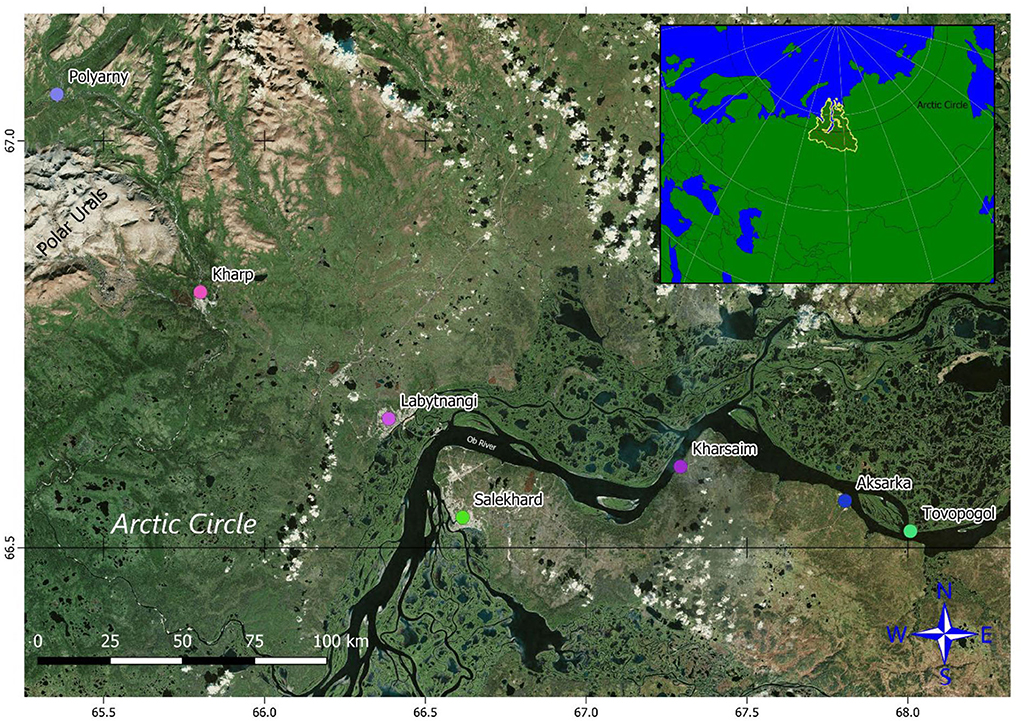
Figure 2. Map of the location of the YANAO on the map of Russia and the main settlements in the study area.
Agroclimatic conditions (Table 1) are given according to the works of Tikhanovsky (2021) for the Salekhard city area. The growing season in this area begins in early June and ends in mid-September, the duration of the growing season is about 100 days. The duration of active plant growth is about 70 days. In 2021, the vegetation period lasted for 145 days, with the sum of temperatures >5°C is equal to 1,536°C (Table 2).
The study was conducted in several settlements of the Yamal-Nenets Autonomous District. The first settlement is the village of Tovopogol. This is a small, almost abandoned village, located on the left side of the Ob River. In summer, one can come here only by water, and in winter, the local population comes here through the river ice. The total population is unknown, according to local people in the village in 2021, there are about 50 residents. The nearest large settlement is the village of Aksarka (4,956 residents), which is 10 km downstream of the Ob River on the opposite bank. We found several private vegetable gardens and greenhouses in the village. Locals grow vegetables (cucumbers and tomatoes) in the greenhouse (Figure 3) and potatoes in the uncovered soil. The design of the greenhouse is very atypical. As shown in the chart (Figure 3), the main shell of the greenhouse is lifted 20–30 cm above the soil cover. The greenhouse has a floor of wooden boards, on which boxes with soil and organic compost are installed and in which the crops are planted. Such methods allow isolating the root system of plants from the influence of permafrost and regulating the temperature regime of the ground in the greenhouse. As previously mentioned, pristine soils in the Far North do not have a high level of fertility, so locals make composts. Compost is placed in wooden boxes inside the greenhouses or directly placed into the topsoil horizons when planting vegetables in the open. The villagers collect various organic wastes, mix them with wood ash, manure, and grass clippings and add local soil (from organic layers), after 6–12 months, the compost is ready for use.

Figure 3. Greenhouses and vegetable gardens in Tovopogol Village. (A) The layout of the greenhouse, where: A, wooden boxes; B, an air gap between the soil cover and the greenhouse floor (20–30 cm); C, organic compost; and D, wooden floor (sometimes it is additionally insulated with a layer of polystyrene). (B,C) Photographs of the greenhouse and vegetable garden. (D) Wooden box for organic compost.
As the population in Tovopogol is rapidly decreasing, the village has several abandoned vegetable gardens. The one we found, according to the villagers, was abandoned about 25 years ago.
The second research plot is located in Polyarny village. Polyarny was founded in the 1940s near the Chum-Labytnangi railway line in a highland area among the Ural Mountains. Thus, since 2004, the village has been in a state of abandonment (Figure 4), with only a few people living there in summer, who service the railroad and deliver products for the herdsmen.
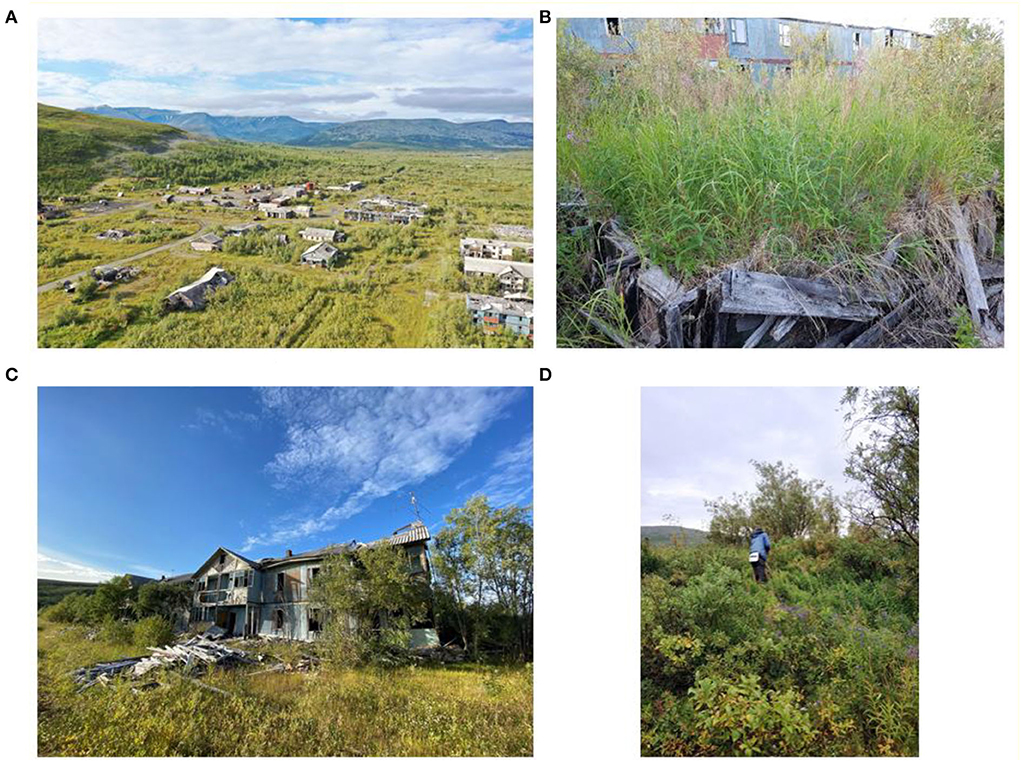
Figure 4. Abandoned the village of Polyarny. (A,B) Photographs of the abandoned village of Polarny. (C) Abandoned greenhouse. (D) Abandoned vegetable garden.
The greenhouses here were used to grow vegetables and fresh greens, and the gardens were used for potatoes and some other root crops. There was no industrial vegetable farming in the village, only a few private greenhouses and vegetable gardens. The greenhouses in Polyarny were built using the same technology as in Tovopogol village (Figure 3). Large wooden boxes were filled with soil or mulch, which was raised above the soil cover. Since 2004, the boards have partially rotten, but it is still possible to notice them.
The third research site located in the vicinities of the city of Labytnangi (left bank of the Ob River, opposite the city of Salekhard) consists of private houses with abandoned vegetable gardens and greenhouses (Figure 5). We can assume that these areas have been abandoned for <10 years.
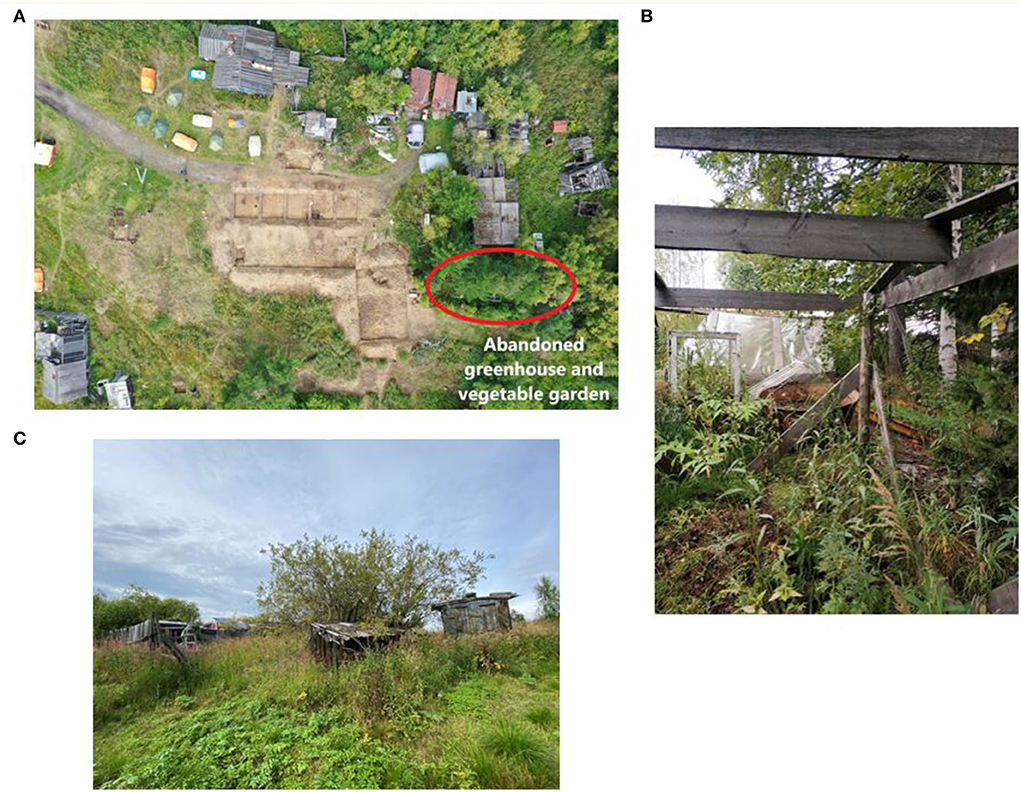
Figure 5. Vicinities of the city of Labytnangi. (A) Archaeological sites in the city of Labytnangi (an ancient settlement of the Komi people). (B,C) photos of the abandoned vegetable garden and greenhouse.
The greenhouse is arranged according to the classic scheme, and a layer of compost is poured on the open sandy parent material, over which a polyethylene roof is built. Similarly, for the vegetable garden, only the layer of compost is located under the open sky.
The soil cover of the Far North is not primarily adapted to vegetable farming and does not have favorable agronomic properties (Stanek, 1970). The soil genesis in the Arctic (tundra and forest-tundra) zones is closely connected with the active permafrost layer development. Permafrost-bounded soil-forming rocks create water retention and intensify the gleyic and redoximorphic processes. In the transitional areas of forests tundra and northern taiga, bog and podzol processes of soil formation prevail (Liwerovsky, 1937; Zubrzycki et al., 2014). Mature soils of our study area are characterized by high acidity (pH from 3.5 to 6), anaerobic-gleyic processes, low biochemical activity, slow processes of nitrification, and aerobic nitrogen fixation and nutritional deficiencies (Liwerovsky, 1937; Targulian, 1971; Tedrow, 1977). Typical pristine natural soils in arctic tundra are not enriched in basic nutrients (Jonasson et al., 1999; Mack et al., 2004). Previously published data show that natural soils in the vicinity of Salekhard contain few mobile forms of phosphorus (up to 100 mg kg−1). Concentrations of available potassium are also at a low level. Near the village of Yamgort, the content of potassium in the topsoil was recorded to be below 90 mg kg−1. According to the FAO International Classification, the dominant soil groups in the study area are Podzols and Cryosols (Abakumov et al., 2020; Nizamutdinov et al., 2021; Alekseev and Abakumov, 2022).
The objects of the study were searched by interviewing the local population. Samples were taken from each genetic soil horizon. The morphological features and soil classification were described according to the (WRB, 2015). After sampling, the samples were placed in hermetically sealed sterile plastic bags. After finishing fieldwork, the soils were transported to the laboratory for further analysis, where they were air-dried at 24°C, grounded, and passed through a 2-mm sieve. The pH values were determined using the pH/ORP/Temperature Portable Meter Milwaukee Mi 106 (Romania) by potentiometric method (soil solution ratio of 1:2.5) with H2O or 1 M CaCl2 (FAO, 2021b). Basal respiration was determined by closed cell method by capturing CO2 emission from samples with 1 M NaOH solution followed by titration with 0.5 M HCl solution in the presence of phenolphthalein and bromocresol indicators (Jenkinson and Powlson, 1976). Soil organic carbon (SOC) content is determined by the Tyurin method, based on the oxidation of soil organic matter with a mixture of potassium dichromate and concentrated sulphuric acid (FAO, 2021a). Determination of organic carbon was carried out in triplicate, and the mean values are given. The stock of SOC (volumetric concentrations) is estimated according to the following formula:
Where: C is the SOC content, %; h is the depth of the soil horizon, cm; and d is the soil compaction density, g cm-3.
The content of ammonium nitrogen (N-NH4) and nitrate-nitrogen (N-NO3) was determined using the potassium chloride solution (ISO, 2003). The content of potassium (K2O) and phosphorus (P2O5) was determined by the Kirsanov method (VNIIA., 2013). The method is based on the extraction of mobile compounds of phosphorus and potassium from the soil with a solution of 0.2 M HCl (1:5) with photocolorimetric or flame-photometric determination of nutrient concentrations. For organomineral horizons, the determination of the main nutrients was repeated two times.
Laboratory tests were performed in certified laboratories. Measurement control was carried out with standardized soil samples (samples with known physical and chemical parameters). The data were visualized and processed using QGIS 3.16, GraphPad Prism 9, and Grapher 13.
At first look, it may seem that the climatic conditions of the Polar Regions are completely unsuitable for vegetable farming, but the Polar Regions have some advantages compared to temperate latitudes. It is well-known that the amount of solar radiation plays a key role in plant growth and as you move to northern latitudes, the duration of daylight hours increases significantly (Szeicz, 1974; Mølmann et al., 2021). In addition, due to a more transparent atmosphere, the light here is richer in ultraviolet radiation. In YANAO, the duration of daylight hours at the beginning of the growing season is about 23 h, the 24-h daylight period lasts on average from early June to early July, and by the end of the growing season, the duration of daylight hours is about 14 h. Consequently, the lack of temperature is compensated by the length of daylight hours (Liwerovsky, 1937; Tikhanovsky, 2021). It should also be noted that high humidity, sufficient precipitation, the absence of the harmful effects of high and some agronomic practices which will be described further in the article create favorable conditions for olericulture. To increase the fertility of local soils, manure is often used as fertilizer, various ameliorants such as ash and NPK are also applied, and sometimes liming of the surface soil horizons is done to reduce its acidity (Alekseeva, 2017; Abakumov et al., 2020; Abakumov and Morgun, 2021; Tikhanovsky, 2021; Nizamutdinov et al., 2022; Suleymanov et al., 2022). Below, we will analyze in detail the soils of the active and abandoned vegetable gardens found in the above-mentioned settlements.
Soils from the greenhouse and vegetable garden were a loose root-rich, dark-colored mixture, up to 30 cm thick in the greenhouse, and up to 40 cm thick in the vegetable garden. The results of the chemical analysis (Figure 6) showed that the soils were neutral or slightly acidic, with low potential acidity (pH H2O 6.2–7.2). The SOC content is high, more than 15%, but its stock is low because the soils are not dense.
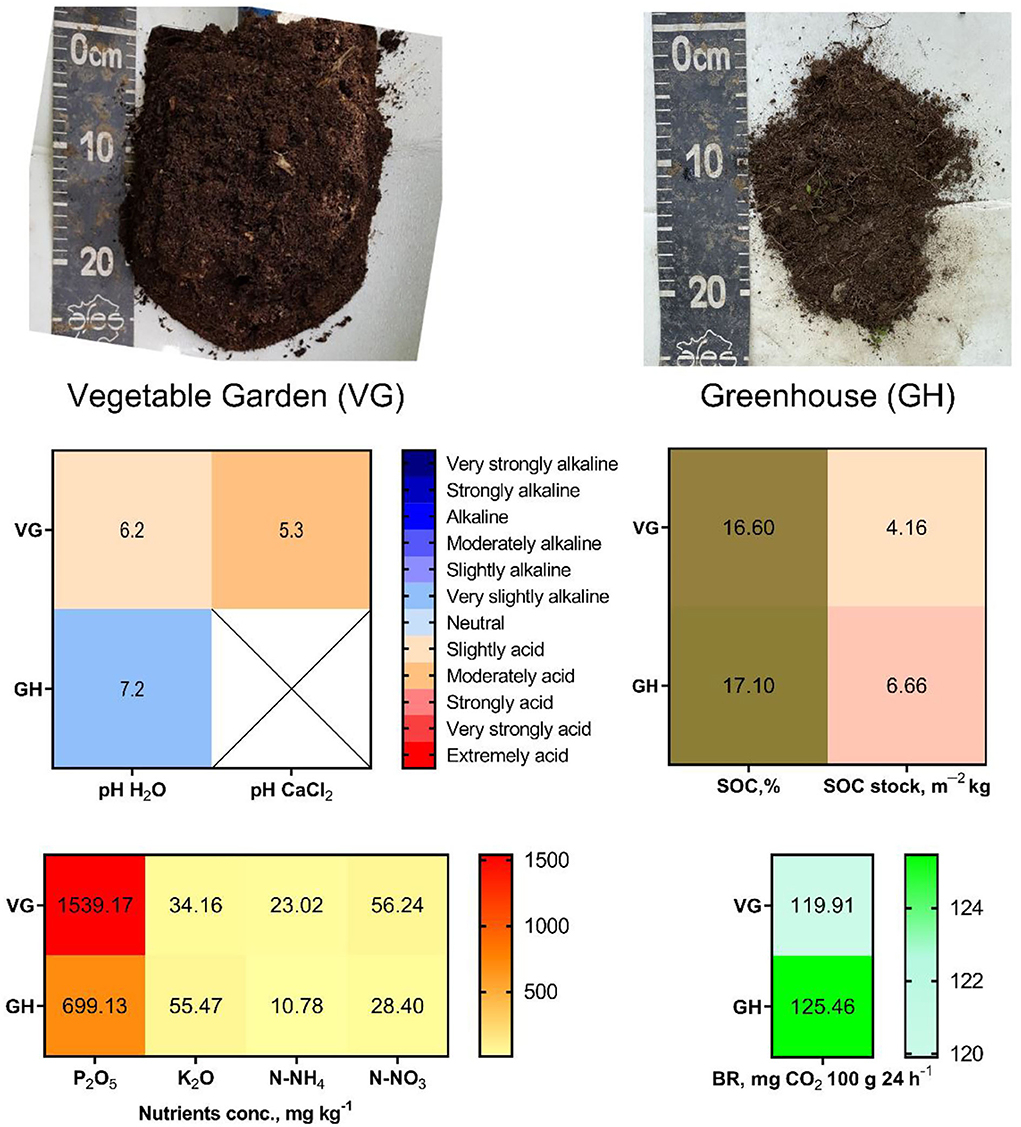
Figure 6. Main soil properties in greenhouse and vegetable garden. Soil name: Hortic Anthrosols (WRB, 2015).
The soils of the greenhouse and vegetable garden contain an extremely high content of available phosphorus (up to 1,539 mg kg−1), probably due to the usage of compost and fish wastes. At the same time, soils are not enriched with potassium if its content is below 60 mg kg−1. The concentration of nitrate nitrogen is higher than that of ammonium nitrogen, which indicates the predominance of nitrification processes over denitrification.
As mentioned in Section Some particularities of the study sites and research plots, locals use special composting methods and greenhouse designs to improve the production of crops and soil fertility. Previously, according to local villagers, composts were made only from fish waste, which had a positive effect on the harvest. The usage of fish composts is not unique to Arctic regions, fish waste has traditionally been used as fertilizer since ancient times, for example, by Indians in North America (Ceci, 1975), in Alaska (Chambers, 2011), and is actively used in agriculture today (Frederick et al., 1989; López-Mosquera et al., 2011; Ahuja et al., 2020; Lanno et al., 2020). Fish fertilizers and composts decompose quickly and significantly enrich soils with nutrients (especially N and P) (López-Mosquera et al., 2011; Radziemska et al., 2019; Muscolo et al., 2021), so their application in nutritional deficit conditions in the Arctic soils is very reasonable and gives good results.
The soils of the abandoned vegetable garden are over-moistened, the profile is marked with gleyic colors and redoximorphic features (Figure 7), the topsoil horizons are full of undecomposed pieces of wood, and sometimes there are anthropogenic artifacts (broken glass and other debris), especially in the Apu1 (20–30 cm) horizon. Compost for fertilization was also used here earlier, but of lower quality than at the previous site.
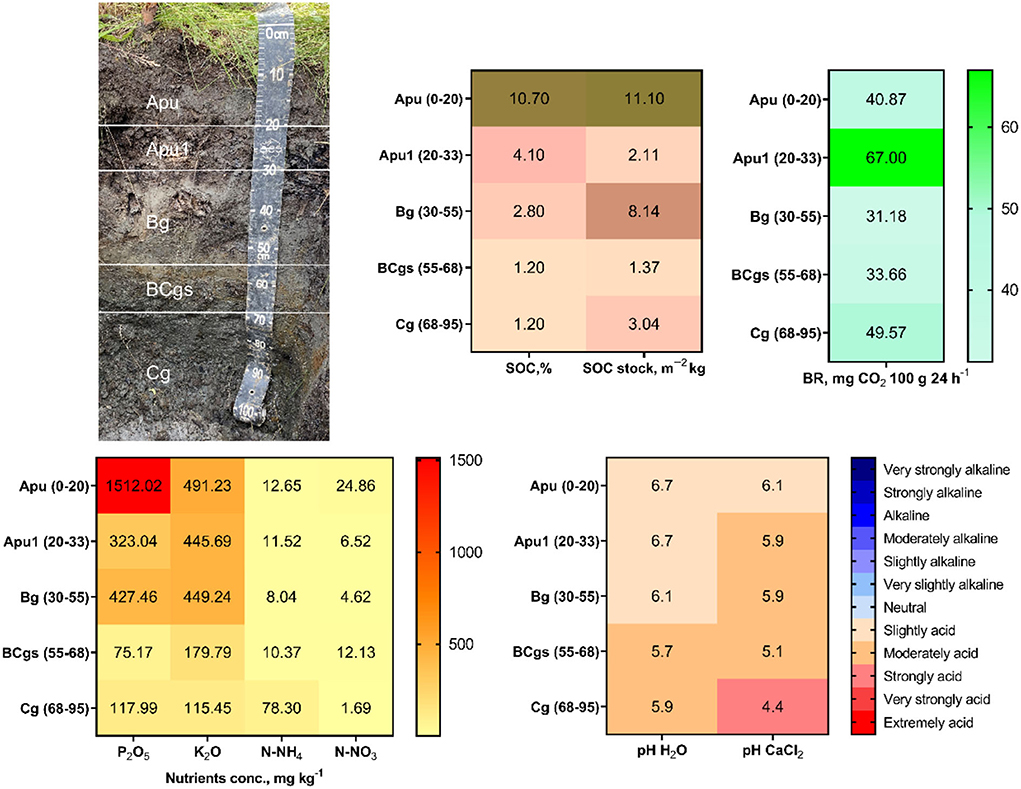
Figure 7. Main soil properties in the abandoned vegetable garden. Soil name: Plaggic Gleyic Anthrosol (WRB, 2015).
The soil is slightly acidic (pH H2O 5.9–6.7), with low potential acidity in the topsoil horizons (pH CaCl2 5.9–6.1) in the most over-moistened BCgs (55–68 cm) and Cg (68–95 cm) horizons, the pH values decrease. The predominance of stagnant, anaerobic conditions explains the low basal respiration of the soil. Therefore, the processes of nitrification are most intense in the most aerated, surface horizon Apu (0–20 cm), which can be estimated by the high content of nitrate nitrogen (24.86 mg kg−1). The content of SOC in the postagrogenic horizons is over 10%, the carbon stock is higher than in the greenhouse and vegetable garden, and the soils are more compact. Among the nutrition elements, the highest content is phosphorus (more than 1,510 mg kg−1), and this soil is also characterized by a high content of potassium (up to 491 mg kg−1).
The soil of the abandoned greenhouse in Polyarny village is presented by a thick (30 cm) humus-accumulative horizon, which can be divided into three parts by density (Figure 8). The soils here are highly degraded, during the 18 years of abandonment, they are acidic (pH H2O−5.7, pH CaCl2 4.6–5.2) and the content of SOC does not exceed 3%. Stopping fertilizer application reduced basal respiration. Since the soils were not isolated from precipitation for a long time, this led to the removal of nutrients from the profile, the content of available phosphorus (137–142 mg kg−1) and nitrogen (N-NH4–up to 4.7 mg kg−1, N-NO3–up to 11.91 mg kg−1) here is significantly lower compared with the soil of the greenhouse in the Tovopogol village. In general, the distribution of the main agrochemical significant parameters in this soil is homogeneous and changes weakly with depth. Perhaps, good drainability (since the greenhouse is located above the natural soil cover) led to the loss of the initial fertility formed by the application of fertilizers.
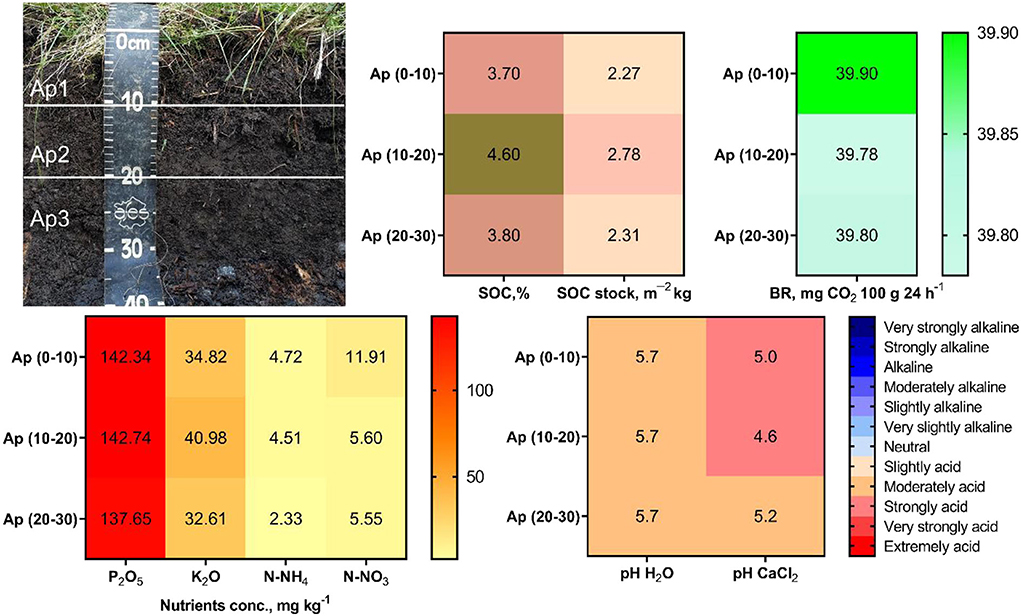
Figure 8. Main soil properties in the abandoned greenhouse. Soil name: Hortic Anthrosol (WRB, 2015).
The next object is an abandoned vegetable garden located close to an abandoned private house and placed on a local elevation of the relief (Figure 9). The house and the vegetable garden were organized on a sandy bank, since the parent rocks here are significantly different from the natural moraine deposits. The humus-accumulative horizon here is shallow, with SOC content <8%, and poorly stocked with a relatively high basal respiration rate. The soil is acidic, pH H2O > 6, changing to slightly alkaline with depth and high potential acidity (pH CaCl2 3.8–4.1). Since the mineral horizons have a sandy texture and the vegetable garden is located on the elevation of the relief, the conditions for high water infiltration capacity of this soil are formed. Therefore, we can observe the migration of nutrients to the depth, especially because it is characteristic for the available forms of phosphorus.
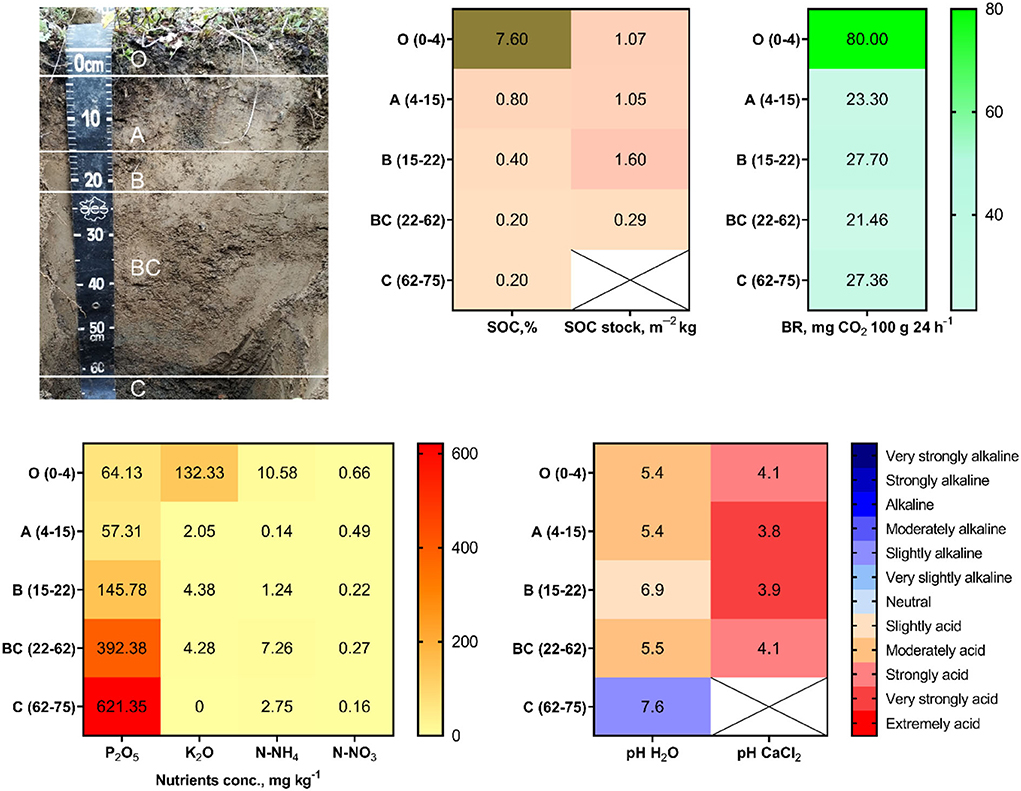
Figure 9. Main soil properties in the first vegetable garden in Polyarny village. Soil name: Plaggic Anthrosol (WRB, 2015).
Another abandoned vegetable garden in the village of Polarny, probably formed on the site of an old burning, with many anthropogenic artifacts and charcoal in the Ap2 (20–30 cm) horizon (Figure 10). Above it is the surface of the postagrogenic Ap1 (0–20 cm) horizon, formed by nearly decomposed organic matter from grassy plants with the addition of dark-colored organic matter. The boundary between the postagrogenic and mineral horizons is harsh, in color and texture, and the parent materials are formed of rubble skeletal moraine sediments. This soil is slightly acidic (pH H2O 5.5–6.6, pH CaCl2 3.8–5.3), with a high SOC content in the post-pyrogenic horizon Ap2 (20–30 cm) (more than 14%), and in the topsoil horizon, SOC content is slightly above 5%. There is an extremely high content of available phosphorus in the surface horizon, more than 2,000 mg kg−1, and concentrations of other nutrients are significantly lower. The content of nitrogen, both ammonium and nitrate, is below 8 and 3 mg kg−1, respectively.
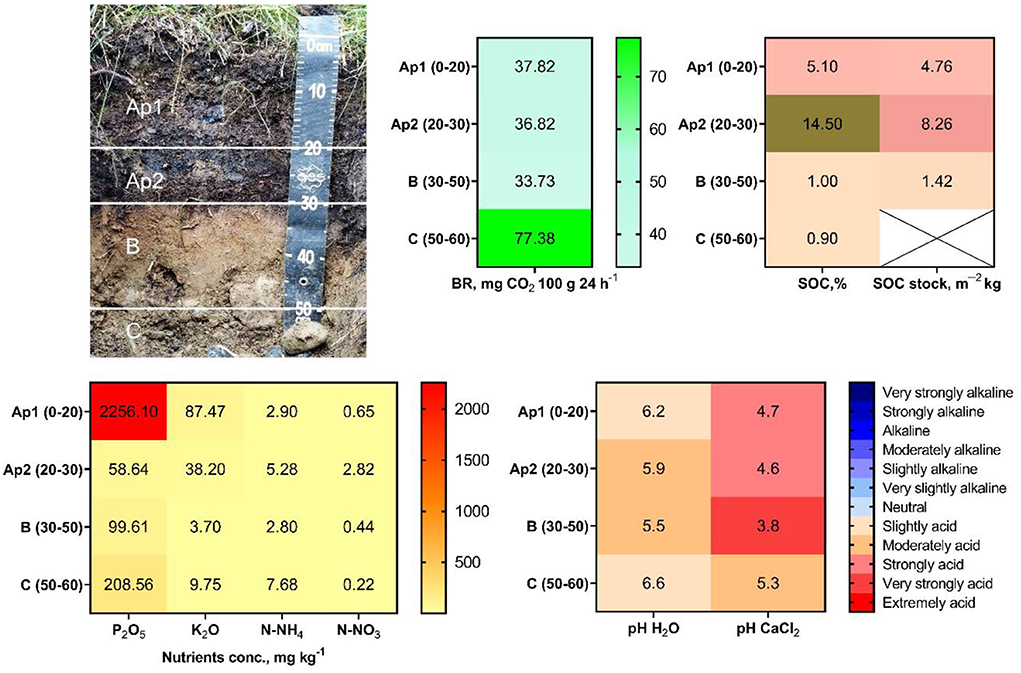
Figure 10. Main soil properties in the second vegetable garden in Polyarny village. Soil name: Hortic Anthrosol (WRB, 2015).
The abandoned greenhouse formed a thick humus horizon up to 18 cm deep, which is underlain by a sandy loam illuvial-iron Bs horizon (Figure 11). Soils of the abandoned greenhouse have retained a high level of fertility: the topsoil horizon (0–18 cm) contains high content of SOC (10.5–16.5%). The soil is slightly acidic (pH H2O 5.6–5.9) with high potential acidity (pH CaCl2 4.4–4.5). There is a high content of nutrients, especially available phosphorus (up to 1,200 mg kg−1) and potassium (up to 397 mg kg−1). The maximum content of nitrogen in the topsoil 0 to 18 cm is N-NH4 up to 15 mg kg−1 and N-NO3 up to 21 mg kg−1.
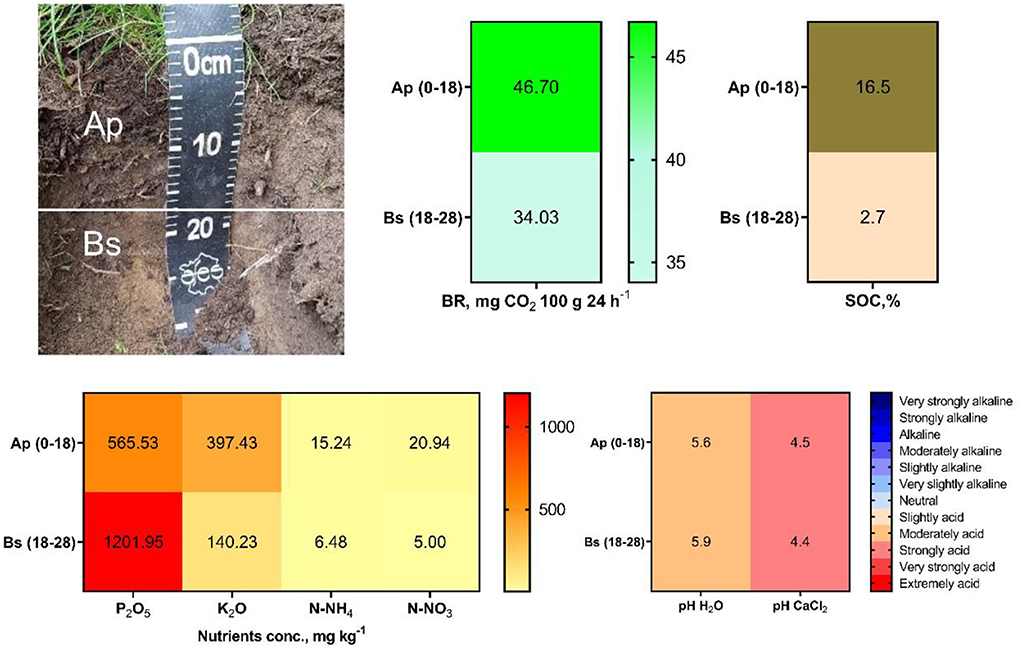
Figure 11. Main soil properties of abandoned greenhouse in Komi village. Soil name: Hortic Anthrosol (WRB, 2015).
The soil in the abandoned vegetable garden (Figure 12) is characterized by lower agrochemical qualities. It is also acidic (pH H2O 5.1–5.9, pH CaCl2 3.8–4.5), but the contents of SOC (10.5% in topsoil) and nutrients are lower compared to the soil of the abandoned greenhouse.
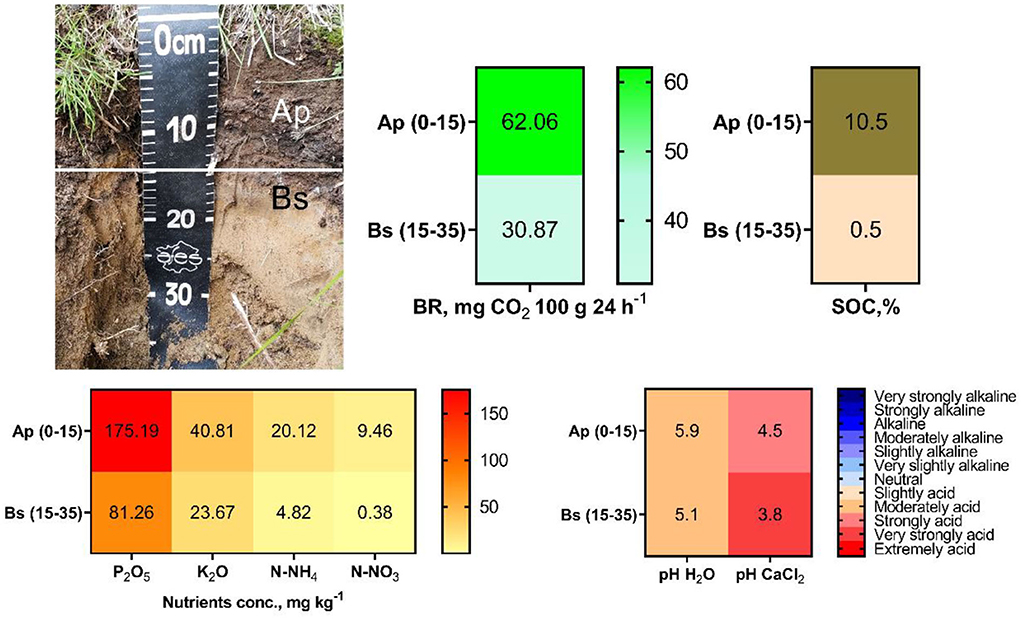
Figure 12. Main soil properties of abandoned private garden in Komi village. Soil name: Hortic Anthrosol (WRB, 2015).
From the morphological aspect, these two profiles are very similar, but chemically, they differ quite significantly. Isolation of soils in the greenhouse contributes to the regulation of temperature and water regimes, which may be the reason for the accumulation of nutrients in the soil profile.
Earlier studies on the assessment of soil fertility in working and abandoned industrial olericultural fields have been conducted at the territory of Salekhard city (Alekseev and Abakumov, 2018; Nizamutdinov et al., 2021, 2022; Tikhanovsky, 2021; Suleymanov et al., 2022). According to Tikhanovsky (2021), the experimental field plot developed the next agrochemical characteristics in the arable topsoil horizon (0-20 cm) during the 30-year development period: pH−5.75; SOC−3.08%; P2O5−263 mg kg−1, K2O−150 mg kg−1 (Figure 13). The following parameters were recorded in the Yamal Experimental Agricultural Station field (abandoned plot): pH−4.95, SOC−3.2%, P2O5−570 mg kg−1, K2O−140 mg kg−1; N-NH4−18 mg kg−1; N-NO3−2.8 mg kg−1. A recently abandoned agricultural field had the following: pH−5.15; SOC−2.8; P2O5−522 mg kg−1; K2O−284 mg kg−1; N-NH4−6.86 mg kg−1; N-NO3−16.72 mg kg−1 (Nizamutdinov et al., 2021, 2022). These plots are farmed scientifically with regular application of mineral and organic fertilizers (NPK, manure, etc.).

Figure 13. Main nutrients content (mean ± SEM) in arable soil layer (0–20 cm) in private (active and abandoned) and industrial olericultural facilities, data were obtained from this study and from Nizamutdinov et al. (2021), Tikhanovsky (2021), and Nizamutdinov et al. (2022).
However, as described above, private olericulturals can achieve significantly higher soil fertility values, especially in greenhouses. In Tovopogol village, when using fish composts, it is possible to achieve the content of available phosphorus above 1,500 mg kg−1, as well as, by drainage of soils to approach pH values to neutral. The SOC content is higher compared to industrial olericultural fields, 16 vs. 3%. Significant differences are observed in the content of potassium, but in industrial fields, it comes mainly from the application of mineral fertilizers, and organic compost is often not enriched with potassium because the main sources of potassium are the products of weathering minerals.
The application by private vegetable growers of such practices as composting, mulching, and adaptation of greenhouses to the conditions of the Far North allows them to raise the fertile qualities of Arctic soils to a new level and obtain stable harvests of potatoes, cucumbers, tomatoes, beets, turnips, and even berries. Permafrost conditions force the local community to elevate greenhouses above the soil cover; this reduces the impact of subzero temperatures on the crop, protects it from harmful pests, and makes it easy to regulate the soil's water regime. The soils of private vegetable farms are radically different in properties from the originally unsuitable for vegetable-growing tundra and forest-tundra soils, and local people manage to create a “new soil” and adapt it to local climatic conditions. Soils of private greenhouses are enriched with organic carbon (content up to 17.1%) and phosphates available to plants (content up to 1,550 mg kg−1). There is a lack of available potassium (content up to 55 mg kg−1), as mineral fertilizers are practically not used by residents. Such soils can be classified as agroconstructozems (or Anthrosols according to FAO classification).
The morphological features of the structure of the soil profile of post-agrogenic soils are fundamentally different from the natural, typical for the YANAO soils. The soils of abandoned vegetable and greenhouse gardens have maintained a high level of fertility after a long period of abandonment. We observed thick humus-accumulative horizons (up to 20 cm) rich in organic matter in soils that were abandoned up to 25 years ago. The soils of the abandoned vegetable garden in the Tovopogol settlement are extremely rich in organic carbon (10.7% content in topsoil) and available to plants in the form of phosphorus and potassium (content up to 1,510 mg kg−1 and up to 491 mg kg−1, respectively). Also, an acid-alkaline regime favorable for vegetation was preserved here.
Abandoned soils at other study sites also showed high fertility capabilities and are potentially suitable for agricultural reclamation. For example, the soils of abandoned vegetable and greenhouse gardens in the outskirts of Labytnangi are characterized by a high content of nutrients (P2O5–up to 1,200 mg kg−1, K2O—up to 400 mg kg−1) and organic carbon—up to 16.5%. Extremely high levels of available phosphorus (up to 2,250 mg kg−1) were recorded in the soil of an abandoned vegetable garden 18 years ago in the village of Polarny. However, the potassium and nitrogen contents here are very low.
Vegetable garden soils react differently in the transition to an abandoned state. Excessive moisture and low temperatures typical of the Arctic region help “conserve” the fertile qualities of soils. Interruption of agricultural usage of vegetable gardens leads to the return of over-moistening and low temperatures; therefore, it creates reduction conditions, anaerobic and gleic processes of soil formation return, a slowdown of microbiological processes of nitrification, and aerobic nitrogen fixation.
A comparison of our data with previously published studies showed that the soils of active and abandoned private olericultural facilities are not behind those of industrial agricultural fields in terms of soil fertility. The soils of private farms are often richer in phosphorus available to plants, but they are less in potassium content because local residents practically do not use mineral fertilizers.
The next step is to perform reconnaissance research and monitoring of fallow agricultural soils beyond the polar circle. Research on circumpolar agricultural soils should certainly continue since they are “hidden” natural resources. It is necessary to understand how much fallow fertile soils are located beyond the polar circle and to assess their fertile qualities, and currently, this information is not enough. This knowledge will help to quickly launch the process of agro-industrial development of the Arctic, with minimal involvement in the agricultural rotation of pristine soils.
The original contributions presented in the study are included in the article/supplementary material, further inquiries can be directed to the corresponding author.
TN: fieldwork, laboratory analyses, writing—original draft, formal analysis, visualization, and data curation. AS: fieldwork, formal analysis, and visualization. EM: fieldwork and writing—original draft. KY: laboratory analyses and writing—review and editing. EA: conceptualization, resources, supervision, and writing—review and editing. All authors have read and agreed to the published version of the manuscript.
This work was supported by the Ministry of Science and Higher Education of the Russian Federation in accordance with agreement No. 075-15-2022-322 dated 22.04.2022 on providing a grant in the form of subsidies from the Federal budget of the Russian Federation. The grant was provided for state support for the creation and development of a World-class Scientific Center Agrotechnologies for the Future.
The authors sincerely grateful to the Department of External Relations of the YANAO Government and the Arctic Research Center for their help in organizing the field work. The authors would also like to express their sincere gratitude to the residents of Tovopogol and Polyarny for their informational support and for kindly providing the opportunity to take soil samples on private territory. This work is in honor of the 300th anniversary of St. Petersburg State University.
The authors declare that the research was conducted in the absence of any commercial or financial relationships that could be construed as a potential conflict of interest.
All claims expressed in this article are solely those of the authors and do not necessarily represent those of their affiliated organizations, or those of the publisher, the editors and the reviewers. Any product that may be evaluated in this article, or claim that may be made by its manufacturer, is not guaranteed or endorsed by the publisher.
Abakumov, E., and Morgun, E. (2021). The problems of updating agricultural practices in the Yamal-Nenets autonomous region. Biosfera 13, 160–169. doi: 10.24855/biosfera.v13i4.649
Abakumov, E., Morgun, E., Pechkin, A., and Polyakov, V. (2020). Abandoned agricultural soils from the central part of the Yamal region of Russia: morphology, diversity, and chemical properties. Open Agric. 5, 94–106. doi: 10.1515/opag-2020-0010
Adams, R. M. (1989). Global climate change and agriculture: an economic perspective. Am. J. Agric. Econ. 71, 1272–1279. doi: 10.2307/1243120
Ahuja, I., Dauksas, E., Remme, J. F., Richardsen, R., and Løes, A.-K. (2020). Fish and fish waste-based fertilizers in organic farming–With status in Norway: a review. Waste Manag. 115, 95–112. doi: 10.1016/j.wasman.2020.07.025
Alekseev, I., and Abakumov, E. (2018). Permafrost-affected former agricultural soils of the Salekhard city (Central part of Yamal region). Czech Polar Rep. 8, 119–131. doi: 10.5817/CPR2018-1-9
Alekseev, I., and Abakumov, E. (2022). Soil organic carbon stocks and stability of organic matter in permafrost-affected soils of Yamal region, Russian Arctic. Geoderma Reg. 28, e00454. doi: 10.1016/j.geodrs.2021.e00454
Alekseeva, L. V. (2017). The formation of Arctic agriculture in the USSR (Yamal). Bull. Nizhnevartovsk State Univ. 2, 3–10.
Alexeeva, L. V. (2011). Yamal-Nenets Autonomous Okrug in the First Decade of its History (December 1930 - June 1941). Nizhnevartovsk: Nizhnevartovsk State Humanitarian University Press.
Ceci, L. (1975). Fish fertilizer: a native north american practice? Documents and cultural analysis show that Indian cultivation did not include fish fertilizers. Science 188, 26–30. doi: 10.1126/science.188.4183.26
Chambers, I. (2011). Safe and Legal Fish Waste Composting in Alaska. Fairbanks, AK: University of Alaska Fairbanks. doi: 10.4027/slfwca.2011
Chan, H. M., Fediuk, K., Hamilton, S., Rostas, L., Caughey, A., Kuhnlein, H., et al. (2006). Food security in Nunavut, Canada: barriers and recommendations. Int. J. Circumpolar Health 65, 416–431. doi: 10.3402/ijch.v65i5.18132
Dearborn, C. H. (1979). Horticultural limitations and potentials of Alaska's Arctic, particularly the Kobuk River region. Arctic 248–262. doi: 10.14430/arctic2624
Dudarev, A. A., Alloyarov, P. R., Chupakhin, V. S., Dushkina, E. V., Sladkova, Y. N., Dorofeyev, V. M., et al. (2013). Food and water security issues in Russia I: food security in the general population of the Russian Arctic, Siberia and the Far East, 2000–2011. Int. J. Circumpolar Health 72, 21848. doi: 10.3402/ijch.v72i0.21848
FAO (2021a). Standard Operating Procedure for Soil Organic Carbon: Tyurin Spectrophotometric Method. Rome: FAO.
Forbes, B. C. (1999). Land use and climate change on the Yamal Peninsula of north-west Siberia: some ecological and socio-economic implications. Polar Res. 18, 367–373. doi: 10.1111/j.1751-8369.1999.tb00316.x
Frederick, L., Harris, R., Peterson, L., and Kehrmeyer, S. (1989). Compost Solution to Dockside Fish Wastes. Madison, WI: UW Sea Grant Institute.
Hossain, K., Raheem, D., and Cormier, S. (2018). Food Security Governance in the Arctic-Barents Region. (Cham: Springer). doi: 10.1007/978-3-319-75756-8
ISO (2003). Soil quality—determination of Nitrate, Nitrite and Ammonium in Field-Moist Soils by Extraction With Potassium Chloride Solution. Part 1: Manual Method. Geneva, Switzerland: International Organisation for Standardisation.
Ivanov, V. A. (2019). Conditions and opportunities to realize the agricultural potential of the North. Arctica i Sever 20, 25–45. doi: 10.17238/issn2221-2698.2019.35.25
Ivanov, V. A., and Lazhentsev, V. N. (2015). The agricultural sector of economy of the Arctic territories of Russia (case study of the Komi Republic). Izvestiya Komi RAN 3, 132–140.
Jenkinson, D. S., and Powlson, D. S. (1976). The effects of biocidal treatments on metabolism in soil—V: a method for measuring soil biomass. Soil Biol. Biochem. 8, 209–213. doi: 10.1016/0038-0717(76)90005-5
Jonasson, S., Michelsen, A., Schmidt, I. K., and Nielsen, E. V. (1999). Responses in microbes and plants to changed temperature, nutrient, and light regimes in the arctic. Ecology 80, 1828–1843. doi: 10.1890/0012-9658(1999)080[1828:RIMAPT]2.0.CO;2
Lamalice, A., Haillot, D., Lamontagne, M.-A., Herrmann, T. M., Gibout, S., Blangy, S., et al. (2018). Building food security in the Canadian Arctic through the development of sustainable community greenhouses and gardening. Écoscience 25, 325–341. doi: 10.1080/11956860.2018.1493260
Lanno, M., Silm, M., Shanskiy, M., Kisand, A., Orupõld, K., and Kriipsalu, M. (2020). Open windrow composting of fish waste in Estonia. Agronom. Res. 18, 2465–2477. doi: 10.15159/AR.20.194
Lemay, M. A., Radcliffe, J. B., Bysouth, D., and Spring, A. (2021). Northern food systems in transition: the role of the emerging agri-food industry in the Northwest Territories (Canada) food system. Front. Sust. Food Syst. 5:661538. doi: 10.3389/fsufs.2021.661538
Liwerovsky, Y. A. (1937). Soils of the Tundra-Bog Belt in Relation to Farming in the North. Moskow: USSR Academy of Sciences Press.
López-Mosquera, M. E., Fernández-Lema, E., Villares, R., Corral, R., Alonso, B., and Blanco, C. (2011). Composting fish waste and seaweed to produce a fertilizer for use in organic agriculture. Proc. Environ. Sci. 9, 113–117. doi: 10.1016/j.proenv.2011.11.018
Mack, M. C., Schuur, E. A., Bret-Harte, M. S., Shaver, G. R., and Chapin, F. S. (2004). Ecosystem carbon storage in arctic tundra reduced by long-term nutrient fertilization. Nature 431, 440–443. doi: 10.1038/nature02887
McCartney, L., and Lefsrud, M. (2018). Protected agriculture in extreme environments: a review of controlled environment agriculture in tropical, arid, polar, and urban locations. Appl. Eng. Agric. 34, 455–473. doi: 10.13031/aea.12590
Mølmann, J. A. B., Dalmannsdottir, S., Hykkerud, A. L., Hytönen, T., Samkumar, A., and Jaakola, L. (2021). Influence of Arctic light conditions on crop production and quality. Physiol. Plant. 172, 1931–1940. doi: 10.1111/ppl.13418
Muscolo, A., Mauriello, F., Marra, F., Calabrò, P., Russo, M., Ciriminna, R., et al. (2021). AnchoisFert: A new organic fertilizer from fish processing waste for sustainable agriculture. Glob. Chall. 6, 2100141. doi: 10.1002/gch2.202100141
Naumov, A., Sidorova, D., and Goncharov, R. (2022). Farming on Arctic margins: models of agricultural development in northern regions of Russia, Europe and North America. Reg. Sci. Policy Pract. 14, 174–186. doi: 10.1111/rsp3.12273
Nilsson, L. M., and Evengård, B. (2015). “Food security or food sovereignty: what is the main issue in the arctic?,” in The New Arctic, eds B. Evengård, J. N. Larsen, and Ø. Paasche (Cham: Springer), 213–223. doi: 10.1007/978-3-319-17602-4_16
Nizamutdinov, T. I., Abakumov, E. V., and Morgun, E. N. (2021). Morphological features, productivity and pollution state of abandoned agricultural soils in the Russian Arctic (Yamal Region). One Ecosyst. 6:e68408. doi: 10.3897/oneeco.6.e68408
Nizamutdinov, T. I., Suleymanov, A. R., Morgun, E. N., Dinkelaker, N. V., and Abakumov, E. V. (2022). Ecotoxicological analysis of fallow soils at the Yamal experimental agricultural station. Food Proc. Techn. Technol. 52, 350–360. doi: 10.21603/2074-9414-2022-2-2369
Peel, M. C., Finlayson, B. L., and McMahon, T. A. (2007). Updated world map of the Köppen-Geiger climate classification. Hydrol. Earth Syst. Sci. 11, 1633–1644. doi: 10.5194/hess-11-1633-2007
Poeplau, C., Schroeder, J., Gregorich, E., and Kurganova, I. (2019). Farmers' perspective on agriculture and environmental change in the circumpolar North of Europe and America. Land 8, 190. doi: 10.3390/land8120190
Radziemska, M., Vaverková, M. D., Adamcová, D., Brtnický, M., and Mazur, Z. (2019). Valorization of fish waste compost as a fertilizer for agricultural use. Waste Biomass Valoriz. 10, 2537–2545. doi: 10.1007/s12649-018-0288-8
Rosinformagroteh. (2021). Report on the state and use of agricultural land of the Russian Federation in 2019. Moskow, Russia: Ministry of Agriculture of the Russian Federation, Rosselkhoznadzor, All-Russian Institute of Agrarian Problems and Informatics of A. A. Nikonov, V.V. Dokuchaev Soil Science Institute.
Rosreestr. (2008–2020). State (National) Report on the State and Use of Land in the Russian Federation in 2008-2020. Moskow, Russia.
Stanek, Z. (1970). Acclimatization of cultivated plants on the northern limit of agriculture in the USSR. Arctic 23, 51–55. doi: 10.14430/arctic3156
Suleymanov, A., Nizamutdinov, T., Morgun, E., and Abakumov, E. (2022). Evaluation and spatial variability of cryogenic soil properties (Yamal-Nenets Autonomous District, Russia). Soil Syst. 6, 65. doi: 10.3390/soilsystems6030065
Szeicz, G. (1974). Solar radiation for plant growth. J. Appl. Ecol. 11, 617–636. doi: 10.2307/2402214
Targulian, V. O. (1971). Soil Formation and Weathering in Cold Humid Regions:(on Massive-Crystalline and Sandy Polymictic Rocks). Moskow: Publishing House “Nauka”.
Tedrow, J. C. (1977). Soils of the Polar Landscapes. New Brunswick, NJ: Rutgers University Press. p. 638. doi: 10.1097/00010694-197709000-00011
Unc, A., Altdorff, D., Abakumov, E., Adl, S., Baldursson, S., Bechtold, M., et al. (2021). Expansion of agriculture in northern cold-climate regions: a cross-sectoral perspective on opportunities and challenges. Front. Sust. Food Syst. 5, 577723. doi: 10.3389/fsufs.2021.663448
VNIIA. (2013). GOST 54650-2011. Soils. Determination of Mobile Phosphorus and Potassium Compounds by Kirsanov Method Modified by ClNAO. Moskow: Standartinform
Voronina, L., and Yurkevich, M. (2020). “The role of agricultural sector in the socio-economic development of the Arctic zone of the Russian Federation,” in IOP Conference Series: Earth and Environmental Science (IOP Publishing), 012056. doi: 10.1088/1755-1315/539/1/012056
Wesche, S. D., and Chan, H. M. (2010). Adapting to the impacts of climate change on food security among Inuit in the Western Canadian Arctic. EcoHealth 7, 361–373. doi: 10.1007/s10393-010-0344-8
WRB (2015). World reference base for soil resources 2014, update 2015: International soil classification system for naming soils and creating legends for soil maps. World Soil Resources Reports No. 106. Rome: FAO.
Keywords: Arctic, horticulture, agricultural soils, nutrients, fertilizers
Citation: Nizamutdinov T, Suleymanov A, Morgun E, Yakkonen K and Abakumov E (2022) Soils and olericultural practices in circumpolar region of Russia at present and in the past. Front. Sustain. Food Syst. 6:1032058. doi: 10.3389/fsufs.2022.1032058
Received: 30 August 2022; Accepted: 05 October 2022;
Published: 03 November 2022.
Edited by:
Pankaj Kumar Arora, Babasaheb Bhimrao Ambedkar University, IndiaReviewed by:
Anna Paltseva, University of Louisiana at Lafayette, United StatesCopyright © 2022 Nizamutdinov, Suleymanov, Morgun, Yakkonen and Abakumov. This is an open-access article distributed under the terms of the Creative Commons Attribution License (CC BY). The use, distribution or reproduction in other forums is permitted, provided the original author(s) and the copyright owner(s) are credited and that the original publication in this journal is cited, in accordance with accepted academic practice. No use, distribution or reproduction is permitted which does not comply with these terms.
*Correspondence: Timur Nizamutdinov, dGltdXJfbml6YW1AbWFpbC5ydQ==; c3QwODY3NDdAc3R1ZGVudC5zcGJ1LnJ1; Evgeny Abakumov, c3QwMDIxMzVAc3BidS5ydQ==
Disclaimer: All claims expressed in this article are solely those of the authors and do not necessarily represent those of their affiliated organizations, or those of the publisher, the editors and the reviewers. Any product that may be evaluated in this article or claim that may be made by its manufacturer is not guaranteed or endorsed by the publisher.
Research integrity at Frontiers

Learn more about the work of our research integrity team to safeguard the quality of each article we publish.